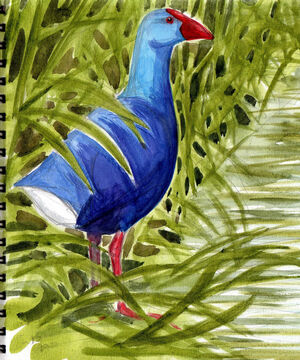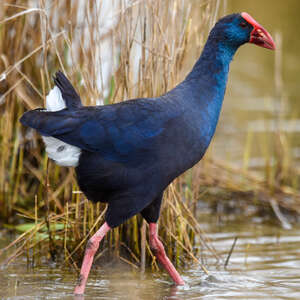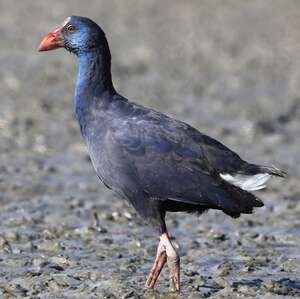Western Swamphen
Porphyrio porphyrio - Talève sultane
Identification
Upperparts are dark purple-blue and throat and chest are turquoise blue. Undertail feathers are pure white (an important characteristic for recognizing it from a distance). Bill is massive and topped with a broad, bright red frontal plate. Its triangular bill with an overhanging upper mandible gives it a strange look. Eyes and legs are also red. Larger and bulkier than the Eurasian Coot (Fulica atra), it differs in having long legs with finger claws also long and tapered, especially the hind claw. Both sexes are identical.
Juveniles generally have an ash-grey blue plumage, with the neck, chest, and belly paler. Although the first blue feathers appear early, they will retain a more dull appearance than an adult until they reach sexual maturity at the age of two. Western Swamphen is a unique species with its large size and striking colors.
Subspecific information monotypic species
Foreign names
- Talève sultane,
- Calamón común,
- camão-ocidental,
- Purpurhuhn,
- kék fú,
- Purperkoet,
- Pollo sultano,
- västlig purpurhöna,
- Blåsultanhøne,
- sultánka modrá,
- slípka modrá,
- Sultanhøne,
- sulttaanikana,
- polla blava,
- Bláhæna,
- modrzyk (zwyczajny),
- sultānvistiņa,
- sultanka,
- Султанка,
- Mandar besar,
- セイケイ,
- 西紫水鸡,
- västlig purpurhöna,
- 紫水雞,
Voice song and call
The call she makes as she takes off sounds like a small trumpet. She has a rich and varied repertoire of loud clucking and soft 'tchouks!', which can be heard from a great distance, especially at dusk. These cries are sometimes echoed in unison by several birds, increasing in intensity as they become more excited.
Habitat
Originating from the tropical zones of the Old World, the Western Swamphen encounters in Europe the northern limit of its distribution area.
The Western Swamphen inhabits the almost impassible reed beds around freshwater and brackish lagoons. It particularly likes the reed beds, broken by canals and water courses.
Behaviour character trait
The Western Swamphen is a sedentary bird. Only the immature birds are erratic, which allows the species to colonize new territories and produce genetic mixing.
It moves around the phragmites with great ease despite its huge legs. It does not hesitate to climb a tuft of reeds from where it observes and sometimes launches its cry. It is easier to spot in winter when the contrast between its dark color and the light brown of the reedbed is the most important.
In deep water it does not move away from the edge of the reedbed where it usually looks for its food. Occasionally it can swim to reach a tuft of reeds further away. It uses its leg, usually the right one, with extraordinary dexterity. It uses it, raised halfway, as a support to cut the vegetation with its powerful beak. Its skill with the legs and the strength of its beak make it a show to observe how it feeds.
Flight
Dietfeeding habits
The Western Swamphen is predominantly vegetarian. It consumes stems, leaves, roots, flowers and seeds from aquatic and semi-aquatic plants. If it feeds on several plants usually present in its habitat (typha, carex, scirpus), it is often Common Reed that forms the largest part of its diet. It is very fond of vegetable sap. Occasionally it can be omnivorous and feed on eggs, chicks, frogs, fish, snails or crustaceans. Generally its providential prey is found dead.
Reproduction nesting
She nests in reed beds, wetlands and moist banks of lakes and rivers with tall herbaceous vegetation.
To do this, she builds a well-hidden floating nest in the heart of the vegetation. It has a bulky structure in the form of a rough cup, but it is relatively small compared to the size of the bird. It is built by both parents with dead leaves and stems of aquatic plants. The couple also builds additional platforms or access ramps used by juveniles to rest.The female usually lays between 2 and 7 eggs of 54.5 X 37 mm, bright cream in color with very variable brownish-reddish or purple spots. Incubation lasting 22 to 25 days is carried out by both sexes but mainly by the female. The chicks are nidifugous and are born with a long down. They leave the nest after four to five days of hatching. Their color is black with a light whitish coating on the back and wings, the legs and fingers are pinkish-red. The forehead plate will be the first to color in red while the beak will have to wait until August to don this color. The growing of the young lasts almost two months until they are fully emancipated. It happens that immatures (from the previous year or from a first clutch) participate in the feeding of the young. The breeding season begins at the end of March. In France, the first egg laying takes place in April/May. There is usually only one clutch, but a second is not uncommon from July to late August.
Geographic range
In Europe, its range extends to the Iberian Peninsula, the Balearic Islands, Sardinia, and the Volga Delta where it reaches its northern limit. The Western Swamphen observed regularly in France since the 1970s has been breeding there since 1996. In 2008 it was found breeding on the Mediterranean coast in the reedbeds of ponds from Roussillon to the Camargue.
Threats - protection
IUCN conservation status
concern
in the Wild
threatened
evaluated
When populations of the Western Swamphen are large, their feeding contributes to limiting the expansion of reedbeds. However, while they help maintain channels and small ponds that break up the reeds, they are unable to destroy their own habitat. The Western Swamphen, despite receiving protection across the environments it inhabits, is sometimes subject to egg theft and hunting. But it is mainly the draining of wetland areas for agriculture or urbanization, combined with pollution from insecticides and lead which still pose a threat.
The increase in its numbers in the northern part of its distribution area must not make us forget its rarefaction in the south of Spain, where the effects of climate change contribute greatly to the drying up of Andalusian lagoons. In France, this bird is still exposed to particularly cold winters.
Sources of information
- IOC World Bird List (v15.1), Gill, F and D Donsker (Eds). 2025-12-07.
Other sources of interest
 Specification sheet created on
02/08/2023 by Jean-Pierre Trouillas
Specification sheet created on
02/08/2023 by Jean-Pierre TrouillasTranslation by AI Oiseaux.net
© 1996-2026 Oiseaux.net
- Accipitriformes
- Aegotheliformes
- Anseriformes
- Apodiformes
- Apterygiformes
- Bucerotiformes
- Caprimulgiformes
- Cariamiformes
- Casuariiformes
- Charadriiformes
- Ciconiiformes
- Coliiformes
- Columbiformes
- Coraciiformes
- Cuculiformes
- Eurypygiformes
- Falconiformes
- Galliformes
- Gaviiformes
- Gruiformes
- Leptosomiformes
- Mesitornithiformes
- Musophagiformes
- Nyctibiiformes
- Opisthocomiformes
- Otidiformes
- Passeriformes
- Pelecaniformes
- Phaethontiformes
- Phoenicopteriformes
- Piciformes
- Podargiformes
- Podicipediformes
- Procellariiformes
- Psittaciformes
- Pterocliformes
- Rheiformes
- Sphenisciformes
- Steatornithiformes
- Strigiformes
- Struthioniformes
- Suliformes
- Tinamiformes
- Trogoniformes

































